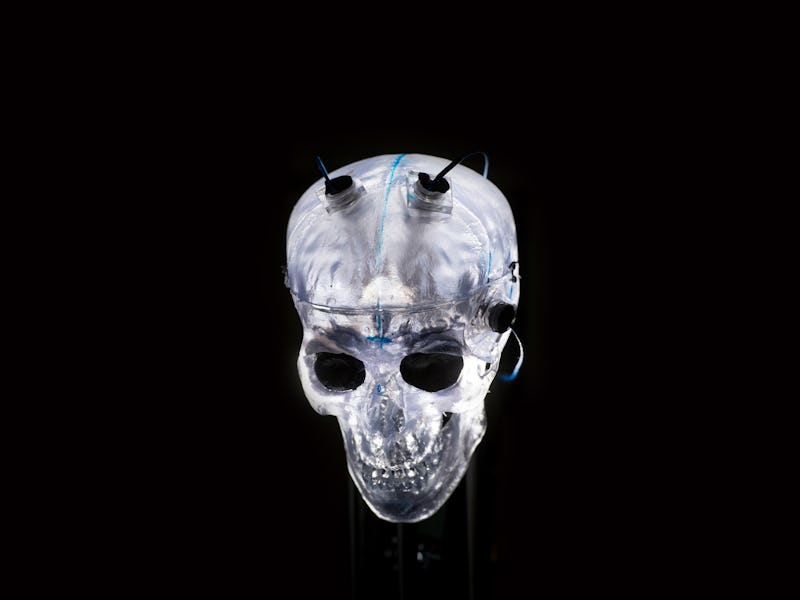Neuroscientists Uncover a Reason Why the Brain Requires Sleep
There are physical differences between a sleeping and waking brain.

One day, we might be able to actively learn in our sleep, but right now we have to settle for consolidating all the new information we learn during the day.
Sleep already has a connection to long-term memory and learning, but a study published Monday in the Journal of Neuroscience proposes a reason why sleep is so important: In a study on adolescent mice, the researchers found that sleeping is responsible for some of the physical changes that prepare the brain to learn each day.
The University of Wisconsin-Madison study focused on synapses, the spaces between two connected neurons. To communicate with one another, neurons release neurotransmitters, chemical messengers that nerve cells use to communicate, into synapses. In the mouse experiment at the heart of the study, the authors found that synapses shrink during sleep and expand during wakefulness.
The finding adds fuel to the hypothesis that sleep “rebalances” synapses in the brain, priming neurons to take on new information upon waking up, somewhat like a dry sponge prepared to take in moisture.
“One hypothesis suggests that sleep’s cognitive benefits stem from its ability to renormalize total synaptic strength, after ongoing learning during wake leads to net synaptic potentiation,” the authors write.
And in this experiment, sleep’s observed effects on synapse size suggest that this hypothesis holds water.
If sleep does help maintain "synaptic homeostasis" then synapses should expand during awake hours and shrink during sleep, these authors posited.
The team proposes that the actual size of synapses is an important way to measure what happens in the brain during sleep because synaptic size is correlated with synaptic strength. As a synapse grows larger, they argue, the connection between the neurons bordering it gets stronger.
In the mice, the team investigated whether that swelling also happens in the hippocampus, an area of the brain particularly involved in learning.
If sleep actually does “rebalance” the brain, then two things should happen: The synapses should swell during the day as the brain is exposed to a plethora of new things and experiences, and they should shrink ever so slightly at night as the brain returns to a “synaptic homeostasis,” as the authors put it, and gets ready to complete that process all over again.
Over time, this cycle leads to a net synaptic potentiation — an overall strengthening of connections that indicates learning or memory consolidation.
That shrinking and swelling dynamic is exactly what Chiara Cirelli, Ph.D., a professor at the University of Wisconsin-Madison’s Center for Sleep and Consciousness, and her team saw in their study.
The team studied synapses in mice who slept for six to eight hours, mice who were spontaneously awoken at night, and mice who were forced to stay up all day while being exposed to “novel objects” or a running wheel. They observed that synaptic size was affected by how much (or how little) the mice slept.
Compared to mice who slept for six to eight hours, the mice who were forced to stay awake had the largest synapses. And although the mice were hyper-stimulated by pulling all-nighters with their new toys, those swollen synapses weren’t actually doing them any favors. Although they were larger, and packed full of presynaptic vesicles — basically holding pens for neurotransmitters — those vesicles weren’t actually “readily available.”
The authors argue that this pattern is suggestive of “presynaptic fatigue,” the idea that our brains are physically taxed after being forced to stay awake. In other words, without sleep, the whole system of synaptic homeostasis gets thrown off balance.
This is just a mouse study, so it’s not enough on its own to make the jump to humans. But it does lay the groundwork for understanding what goes on in the brain during sleep in a physical sense. Here, the most important step forward is that they pinned this shrinking and swelling dynamic down into the hippocampus.
“Thus, the role of sleep in maintaining synaptic homeostasis may extend to the hippocampus, a key area for learning and synaptic plasticity,” they write.
That connection, if it’s confirmed in humans, could go a long way to unveiling one of the crucial ways that sleep changes our brains for the better.
Abstract:
Sleep has been hypothesized to rebalance overall synaptic strength after ongoing learning during waking leads to net synaptic potentiation. If so, since synaptic strength and size are correlated, synapses on average should be larger after wake and smaller after sleep. This prediction was recently confirmed in mouse cerebral cortex using serial block-face electron microscopy (SBEM). However, whether these findings extend to other brain regions is unknown. Moreover, sleep deprivation by gentle handling was reported to produce hippocampal spine loss, raising the question of whether synapse size and number are differentially affected by sleep and waking. Here we applied SBEM to measure axon-spine interface (ASI) - the contact area between pre-synapse and post-synapse — and synapse density in CA1 stratum radiatum. Adolescent YFP-H mice were studied after 6-8h of sleep (S=6), spontaneous wake at night (W=4) or wake enforced during the day by novelty exposure (EW=4; males/females balanced). In each animal ≥425 ASIs were measured and synaptic vesicles were counted in ∼100 synapses/mouse. Reconstructed dendrites included many small, nonperforated synapses and fewer large, perforated synapses. Relative to S, ASI sizes in perforated synapses shifted towards higher values after W and more so after EW. ASI sizes in nonperforated synapses grew after EW relative to S and W, and so did their density. ASI size correlated with presynaptic vesicle number but the proportion of readily available vesicles decreased after EW, suggesting presynaptic fatigue. Thus, CA1 synapses undergo changes consistent with sleep-dependent synaptic renormalization and their number increases after extended wake.